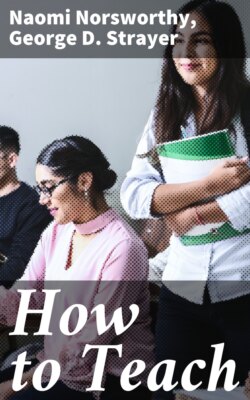How to Teach

Реклама. ООО «ЛитРес», ИНН: 7719571260.
Оглавление
Naomi Norsworthy. How to Teach
How to Teach
Table of Contents
PREFACE
I. THE WORK OF THE TEACHER
QUESTIONS
II. ORIGINAL NATURE, THE CAPITAL WITH WHICH TEACHERS WORK
QUESTIONS
III. ATTENTION AND INTEREST IN TEACHING
QUESTIONS
IV. THE FORMATION OF HABITS
QUESTIONS
V. HOW TO MEMORIZE
QUESTIONS
VI. THE TEACHER'S USE OF THE IMAGINATION
QUESTIONS
VII. HOW THINKING MAY BE STIMULATED
QUESTIONS
VIII. APPRECIATION, AN IMPORTANT ELEMENT IN EDUCATION
QUESTIONS
IX. THE MEANING OF PLAY IN EDUCATION
QUESTIONS
X. THE SIGNIFICANCE OF INDIVIDUAL DIFFERENCES FOR THE TEACHER
QUESTIONS
XI. THE DEVELOPMENT OF MORAL SOCIAL CONDUCT
QUESTIONS
XII. TRANSFER OF TRAINING
QUESTIONS
XIII. TYPES OF CLASSROOM EXERCISES
QUESTIONS
XIV. HOW TO STUDY
QUESTIONS
XV. MEASURING THE ACHIEVEMENTS OF CHILDREN
QUESTIONS
INDEX
Отрывок из книги
Naomi Norsworthy, George D. Strayer
Published by Good Press, 2019
.....
The racial inheritance, the capital which all normal children bring into the world, is usually discussed under several heads: reflexes, physiological actions, impulsive actions, instincts, capacities, etc., the particular heads chosen varying with the author. They all depend for their existence upon the fact that certain bonds of connection are performed in the nervous system. Just what this connection is which is found between the nerve cells is still open to question. It may be chemical or it may be electrical. We know it is not a growing together of the neurones,[1] but further than that nothing is definitely known. That there are very definite pathways of discharge developed by the laws of inner growth and independent of individual learning, there can be no doubt. This of course means that in the early days of a child's life, and later in so far as he is governed by these inborn tendencies, his conduct is machine-like and blind--with no purpose and no consciousness controlling or initiating the responses. Only after experience and learning have had an opportunity to influence these responses can the child be held responsible for his conduct, for only then does his conduct become conscious instead of merely physiological.
There are many facts concerning the psychology of these inborn tendencies that are interesting and important from a purely theoretical point of view, but only those which are of primary importance in teaching will be considered here. A fact that is often overlooked by teachers is that these inborn tendencies to connections of various kinds exist in the intellectual and emotional fields just as truly as in the field of action or motor response. The capacity to think in terms of words and of generals; to understand relationships; to remember; to imagine; to be satisfied with thinking,--all these, as well as such special abilities as skill in music, in managing people or affairs, in tact, or in sympathy, are due to just the same factors as produce fear or curiosity. These former types of tendencies differ from the latter in complexity of situation and response, in definiteness of response, in variability amongst individuals of the same family, and in modifiability; but in the essential element they do not differ from the more evident inborn tendencies.
.....